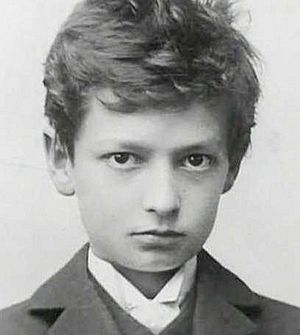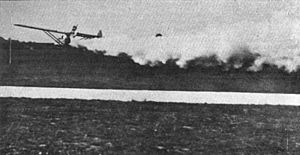Hermann Oberth facts for kids
Quick facts for kids
Hermann Oberth
|
|
|---|---|
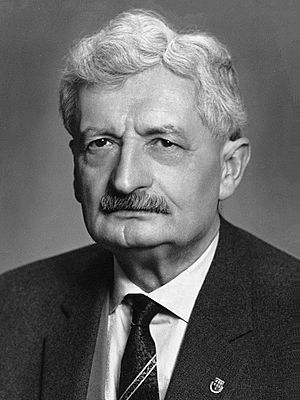 |
|
| Born |
Hermann Julius Oberth
25 June 1894 |
| Died | 28 December 1989 (aged 95) |
| Nationality | Romanian |
| Citizenship | Hungarian, German |
| Alma mater | University of Cluj |
| Awards | Prix REP-Hirsch, 1929; Wilhelm Exner Medal 1969 |
| Scientific career | |
| Fields | Astronautics and physics |
| Doctoral advisor | Augustin Maior |
| Notable students | Wernher von Braun |
| Signature | |
Hermann Julius Oberth (born June 25, 1894 – died December 28, 1989) was a Transylvanian Saxon physicist and engineer. He is known as one of the main founders of rocketry and astronautics. He shares this title with other pioneers like Konstantin Tsiolkovsky and Robert Goddard. During World War II, he helped develop rockets for Germany.
Contents
Early Life and Rocket Dreams
Hermann Oberth was born in a town called Hermannstadt, which is now Sibiu in Romania. He grew up speaking Romanian. When he was 11, he became fascinated with rockets. This happened after reading the adventure novels of Jules Verne, especially From the Earth to the Moon. He read these books many times.
By the age of 14, Oberth built his first model rocket as a school student. He also came up with the idea of a multistage rocket on his own. This type of rocket drops empty fuel tanks as it flies. This makes the rocket lighter and able to go faster. However, he did not have the tools or money to build his ideas then.
In 1912, Oberth started studying medicine in Munich, Germany. But World War I began, and he joined the army. He was sent to fight on the Eastern Front. In 1915, he moved to a hospital unit. There, he found time to do experiments. He also continued working on his rocket designs. By 1917, he showed plans for a liquid-fueled missile. This missile could fly about 290 kilometers (180 miles).
On July 6, 1918, Oberth married Mathilde Hummel. They had four children together. In 1919, Oberth moved back to Germany. He decided to study physics instead of medicine. He studied first in Munich and then at the University of Göttingen.
In 1922, Oberth wrote a paper about rocket science for his doctorate degree. But his ideas were seen as "utopian" and were rejected. However, a professor in Romania, Augustin Maior, gave him another chance. Oberth successfully defended his paper in 1923. He then published his work as a book called Die Rakete zu den Planetenräumen (The Rocket into Planetary Space). He later expanded this book to Wege zur Raumschiffahrt (Ways to Spaceflight). Oberth believed his work proved his scientific ability. He felt he did not need another doctorate title.
Oberth joined the Verein für Raumschiffahrt (VfR), which means "Spaceflight Society." This was a group of people who loved rockets. They were inspired by his book. Oberth became a mentor to them. One of his students was Wernher von Braun. From 1924 to 1938, Oberth taught physics and mathematics in Romania. This helped him support his family.
Rocketry and Space Travel
In 1928 and 1929, Oberth worked in Berlin. He was a science advisor for the film Frau im Mond (The Woman in the Moon). This movie was directed by Fritz Lang. The film helped make people excited about rockets and space exploration. Oberth even designed the model of the main rocket in the film.
In 1929, Oberth won an award for his book Ways to Spaceflight. This award was given by the French Astronomical Society. It was for encouraging space travel.
Oberth's student Max Valier worked with Fritz von Opel. They created the world's first large-scale rocket program, called Opel-RAK. This led to new speed records for vehicles. It also led to the world's first rocket plane. The Opel RAK.1 was flown by von Opel in public in 1929. These events greatly inspired future rocket scientists, including Wernher von Braun.
In 1929, Oberth tested his first liquid-fueled rocket engine. He called it the Kegeldüse. An 18-year-old student, Wernher von Braun, helped him. Von Braun later became a very important rocket engineer. He helped create the huge Saturn V rockets. These rockets took humans to the Moon in 1969.
In 1938, the Oberth family moved from Romania to Germany. Oberth worked at technical colleges in Vienna and Dresden. In 1941, Oberth moved to Peenemünde, Germany. He worked on the Aggregat rocket program there. This program developed powerful rockets. He was recognized for his brave work during an attack on Peenemünde.
After World War II ended, Oberth moved to Feucht, Germany. In 1948, he moved to Switzerland. He worked as a consultant and writer. In 1950, he moved to Italy. He finished some rocket work for the Italian Navy. In 1953, Oberth returned to Germany. He published a book called Menschen im Weltraum (Mankind into Space). In it, he shared his ideas for space stations, electric spaceships, and space suits.
During the 1950s and 1960s, Oberth also shared his thoughts on unidentified flying objects (UFOs). He thought that UFOs might be spaceships from other solar systems. He believed they could be from intelligent beings. He wrote that these beings might have been watching Earth for centuries.
Oberth later worked for his former student, Wernher von Braun. Von Braun was developing space rockets for NASA in the United States. Oberth helped write a study about future space technology. In 1960, Oberth worked for the Convair Corporation. He was a consultant for the Atlas rocket program.
Space Mirror Idea
In 1923, Oberth first described his idea for giant space mirrors. These mirrors would be 100 to 300 kilometers (60 to 180 miles) wide. They would be made of many small, adjustable parts.
These space mirrors would orbit Earth. They could focus sunlight onto specific areas on Earth. Or they could block sunlight to cool certain regions. This would not cool the whole Earth, but only chosen spots.
Oberth thought these mirrors could light up cities. They could also protect against natural disasters. He believed they could control weather and climate. He even thought they could create more living space for billions of people. He felt that influencing weather patterns was most important.
Oberth wrote more about these mirrors over the years. He included new technical progress in his later books. He thought the parts for these mirrors could be made on the Moon. Then, they could be launched into orbit and assembled. In 1978, he guessed these mirrors could be built between 2018 and 2038.
Hermann Oberth also warned that these mirrors could be used as weapons. Because of this, and their complexity, he believed they could only be built as a peaceful project for all humanity. Today, Oberth's space mirror idea is part of "climate engineering." It falls under "solar radiation management." Scientists still discuss the risks of such large projects.
Later Life and Legacy
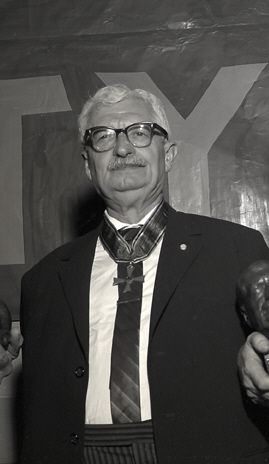
Oberth retired in 1962 when he was 68 years old. In July 1969, Oberth returned to the United States. He wanted to see the launch of the Apollo project Saturn V rocket. This rocket carried the Apollo 11 crew. They were on the first mission to land on the Moon.
The 1973 oil crisis made Oberth think about new energy sources. He even planned a wind power station that could use the jet stream. In his later years, he focused on bigger philosophical questions.
Oberth returned to the United States one last time in 1985. He watched the launch of the Space Shuttle Challenger.
Hermann Oberth died in Nuremberg, West Germany, on December 28, 1989. This was shortly after the fall of the Iron Curtain.
Legacy
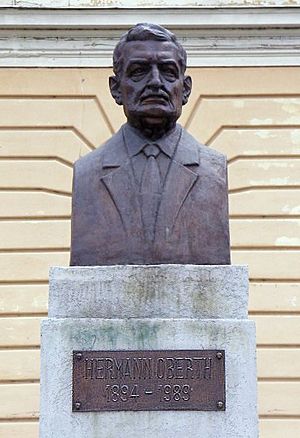
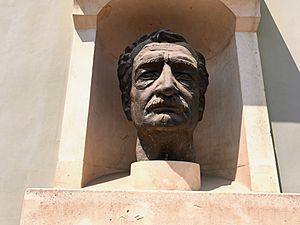
Hermann Oberth is remembered in many ways. There is the Hermann Oberth Space Travel Museum in Feucht, Germany. This museum brings together scientists and astronauts. They continue his work in rocketry and space exploration.
He discovered the Oberth effect. This effect shows that a rocket engine works more efficiently when it is already moving very fast.
In 1980, Oberth was honored in the International Air & Space Hall of Fame. There is also a crater on the Moon and an asteroid (9253 Oberth) named after him.
The Faculty of Engineering at Lucian Blaga University of Sibiu is named after him.
In the Star Trek movies and TV shows, a type of starship is called an Oberth-class starship.
Books
- Die Rakete zu den Planetenräumen (1923) (By Rocket into Planetary Space) (in German)
- Ways to Spaceflight (1929)
- The Moon Car (1959)
- The Electric Spaceship (1960)
- Primer for Those Who Would Govern (1987)
See also
 In Spanish: Hermann Julius Oberth para niños
In Spanish: Hermann Julius Oberth para niños
- Robert H. Goddard
- Outer space
- Konstantin Tsiolkovsky
- List of German inventors and discoverers
- List of Romanian inventors and discoverers


